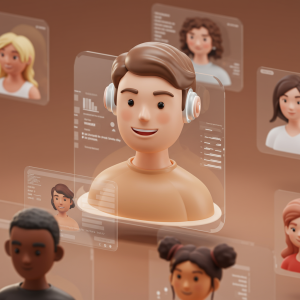The Rise of Virtual Influencers: How Brands Can Leverage Digital Personas in Influencer Marketing

Influencer marketing has evolved rapidly over the past decade, with brands seeking fresh and engaging ways to connect with their target audiences. Enter virtual influencers: fully digital characters powered by advanced design, animation, and artificial intelligence. These AI-driven personas are becoming a force in the social media landscape, offering brands unique advantages at the intersection of creativity and technology.
What Are Virtual Influencers?

Virtual influencers are computer-generated personalities that exist exclusively in the digital world. Unlike human influencers, these characters are crafted by brands, design studios, or agencies and are managed through animation, 3D modeling, and sometimes AI-driven content creation tools. They maintain social media profiles on platforms like Instagram, TikTok, and YouTube, where they post photos, videos, and stories just like human creators. Leading examples include Lil Miquela and Shudu, both of which have amassed millions of followers thanks to their compelling backstories and visually striking imagery.
Why Brands Are Embracing Virtual Influencers
Brands are increasingly drawn to virtual influencers for several reasons. First, they offer complete creative control—every post, comment, and interaction can be scripted to align perfectly with brand values. Second, they mitigate common influencer risks, such as unpredictable behavior or scandals that can harm brand reputation. Third, virtual influencers can operate 24/7 without needing breaks or compensation negotiations, making them cost-effective over the long term. Finally, their futuristic appeal generates buzz and positions your brand as an innovator in the digital space.
Key Benefits of Collaborating with Virtual Influencers
1. Brand Safety and Consistency: Virtual personas behave predictably and adhere strictly to guidelines.
2. Scalability: Clone characters or create spin-offs to target different demographics.
3. Innovation & Differentiation: Stand out in a crowded influencer landscape with a novel approach.
4. Cross-Platform Synergy: Easily repurpose digital assets across social media, websites, and ads.
5. Data-Driven Optimization: Integrate AI analytics to refine content strategies in real time.
Potential Challenges and Ethical Considerations
Despite the advantages, virtual influencers raise unique challenges. Audiences may question authenticity if the distinction between real and digital is unclear. Brands must disclose that the character is fictional to comply with advertising guidelines and maintain transparency. Additionally, cultural sensitivity and representation should be thoughtfully addressed when designing virtual personas to avoid stereotyping or appropriation. Finally, managing the technical complexity of CGI and AI generation may require specialized talent and budget planning.
Case Studies: Brands That Nailed Virtual Influencer Campaigns
1. Calvin Klein & Lil Miquela: This partnership showcased limited-edition apparel worn by the virtual model, driving social engagement and press coverage.
2. Prada & Carlings: The fashion house collaborated with CGI designers to launch a digital-only clothing line, blending virtual art with e-commerce innovation.
3. Samsung & Noonoouri: Teaming with the stylized avatar Noonoouri for product reveals generated excitement among tech and design communities.
How to Choose or Create a Virtual Influencer
1. Define Your Brand Persona: Identify the character traits, tone, and visual style that resonate with your target audience.
2. Partner with Experienced Studios: Collaborate with CGI artists, animators, and AI developers who specialize in digital character creation.
3. Script a Backstory: Craft a narrative that gives your virtual influencer personality and depth—this builds authenticity.
4. Plan a Content Cadence: Determine post frequency, storytelling arcs, and cross-platform strategies for consistent engagement.
5. Ensure Legal Compliance: Disclose endorsements, respect intellectual property, and follow local advertising regulations.
Best Practices for Engaging with Virtual Influencers

• Maintain Authentic Interaction: Encourage user-generated content by hosting Q&A sessions with the virtual influencer.
• Monitor Performance Metrics: Track engagement rates, follower growth, and conversion data to assess ROI.
• Blend Real and Virtual Talent: Co-create campaigns that feature both human and digital influencers for a hybrid approach.
• Leverage Storytelling: Use episodic content to deepen audience connection and maintain interest.
• Iterate Based on Feedback: Use AI analytics to refine visual style, messaging, and posting schedules.
Measuring Success: KPIs for Virtual Influencer Campaigns
To evaluate the impact of your virtual influencer efforts, focus on:
• Engagement Rate (likes, comments, shares)
• Follower Growth & Audience Reach
• Click-Through Rate (CTR) to landing pages or product links
• Conversion Rate (sales, sign-ups, app installs)
• Earned Media Value (press mentions, UGC replication)
Future Trends in Virtual Influencer Marketing
As technology advances, we anticipate:
• AI-Generated Interactive Stories: Real-time chat and personalized experiences.
• Augmented Reality (AR) Appearances: Virtual avatars popping into users’ environments.
• Blockchain Authentication: Verifiable provenance and scarcity for digital assets.
• Multi-Language Localization: Seamless global campaigns through AI translation.
• Emotional AI: Avatars that respond to user sentiment and adjust personality cues.
Conclusion
Virtual influencers represent the next frontier in influencer marketing, offering brands unparalleled creative freedom, consistent brand safety, and a futuristic edge. By carefully planning character design, ethical disclosure, and data-driven content strategies, companies can harness these digital personas to engage audiences in novel ways. Whether you’re experimenting with your first CGI model or integrating AI-powered analytics, virtual influencers can drive excitement, loyalty, and measurable results for forward-thinking brands.
Ready to explore the world of virtual influencers? Start by defining your brand’s digital persona, partnering with expert creators, and crafting a transparent, immersive campaign that sets you apart in today’s crowded social space.





